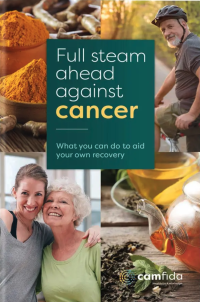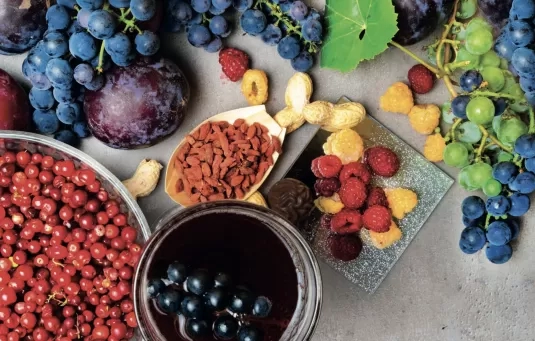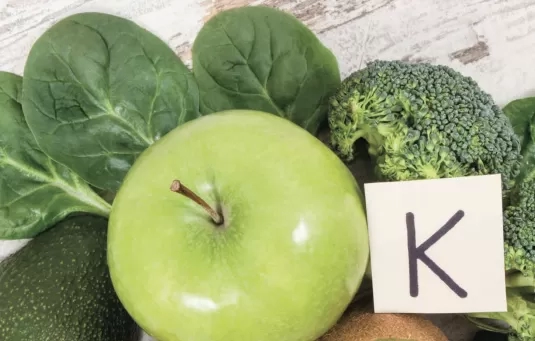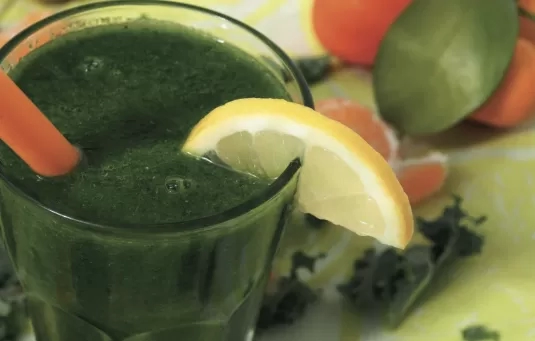Green tea
In the Far East, green tea has been regarded as a health-giving drink for centuries. In the last few decades, a great deal of scientific research has been carried out into the properties of green tea, including for the prevention and the treatment of cancer.
Curcumin
Curcumin is the most active component of turmeric, a spice obtained from the turmeric plant (Curcuma longa). Increasing attention is being paid to curcumin as a natural anti-inflammatory and painkiller, and as a promising substance for the prevention and treatment of cancer. Curcumin is being extensively tested in oncology, especially in combination with chemotherapy (Giordano A, 2019; Tan BL, 2019; Tomeh MA, 2019; Ravindran J, 2009).
Resveratrol
Resveratrol is a substance that some plants produce to protect themselves against fungi, viruses, bacteria, insects, and ultraviolet radiation. It is primarily found in red grapes, berries, cocoa, and peanuts.
It is a widely studied substance with an antioxidant, anti-inflammatory, immune-modulating, and hormone-regulating effect. Resveratrol is widely tested in clinical cancer studies (Mulakayala C, 2013; Ogas T, 2013).
Watercress
Watercress (Nasturtium officinale) is a plant from the family of cruciferous vegetables, whose other members include broccoli and other types of cabbage. Cruciferous vegetables are best known for their high content of sulphur-containing compounds, which are converted during chewing and digestion into more active substances with a detoxifying, antioxidant, and cancer-inhibiting effect.
Sulphur in broccoli
Broccoli is another food that is rich in sulphur-containing compounds with an excellent detoxifying and cancer-inhibiting effect, such as sulphoraphane and indoles. These also modify several genes involved in the development and progression of cancer (Highdon JV, 2007; Nandini DB, 2020; Royston KJ, 2015).
Medicinal mushrooms
Mushrooms have been used for centuries as a natural form of immunotherapy, especially in Asian traditional medicine. The health-giving properties of mushrooms have now been revealed by modern science. These properties are especially promising in terms of boosting resistance and as a complementary treatment for cancer.
Adaptogens
Adaptogens are plants that modulate the stress response and prevent or limit the harmful effects of chronic stress. Although they are mostly known as anti-stress compounds, they actually have a much wider regulating effect in the body.
Cannabis sativa
Cannabis, hemp, and ‘weed’ are different names for the same plant: Cannabis sativa. Preparations of cannabis such as marijuana and hash are best known as a recreational drug on account of their euphoric effects. However, the plant also has a variety of health-giving properties. In China and India, cannabis extracts were already being used two to three thousand years ago as a remedy for, among other things, pain, cramps, and anxiety. In the West, cannabis gained a bad reputation during the twentieth century and its use was prohibited.
References
- Giordano A, Tommonaro G. Curcumin and Cancer. Nutrients. 2019 Oct 5;11(10):2376. doi: 10.3390/nu11102376. PMID: 31590362; PMCID: PMC6835707.
- Tan BL, Norhaizan ME. Curcumin Combination Chemotherapy: The Implication and Effi- cacy in Cancer. Molecules. 2019 Jul 10;24(14):2527. doi: 10.3390/molecules24142527. PMID: 31295906; PMCID: PMC6680685.
- TomehMA,HadianamreiR,ZhaoX.AReviewofCurcuminandItsDerivativesasAnticancer Agents. Int J Mol Sci. 2019 Feb 27;20(5):1033. doi: 10.3390/ijms20051033. PMID: 30818786; PMCID: PMC6429287.
- RavindranJ,PrasadS,AggarwalBB.Curcuminandcancercells:howmanywayscancurrykill tumor cells selectively? AAPS J. 2009 Sep;11(3):495-510. doi: 10.1208/s12248-009-9128-x. Epub 2009 Jul 10. PMID: 19590964; PMCID: PMC2758121.
- MulakayalaC,BabajanB,MadhusudanaP,etal.Synthesisandevaluationofresveratrolderiva- tives as new chemical entities for cancer. J Mol Graph Model. 2013 Apr;41:43-54.
- Ogas T, Kondratyuk TP, Pezzuto JM. Resveratrol analogs: promising chemopreventive agents. Ann N Y Acad Sci. 2013 Jul;1290:21-9. doi: 10.1111/nyas.12196. PMID: 23855462.
- Higdon JV, Delage B, Williams DE, et al. Cruciferous vegetables and human cancer risk: epi- demiologic evidence and mechanistic basis. Pharmacol Res. 2007 Mar;55(3):224-36. doi: 10.1016/j.phrs.2007.01.009. Epub 2007 Jan 25. PMID: 17317210; PMCID: PMC2737735.
- NandiniDB,RaoRS,DeepakBS,etal.Sulforaphaneinbroccoli:Thegreenchemoprevention!! Role in cancer prevention and therapy. J Oral Maxillofac Pathol. 2020 May-Aug;24(2):405. doi: 10.4103/jomfp.JOMFP_126_19. Epub 2020 Sep 9. PMID: 33456268; PMCID: PMC7802872.
- Royston KJ, Tollefsbol TO. The Epigenetic Impact of Cruciferous Vegetables on Cancer Pre- vention. Curr Pharmacol Rep. 2015 Feb 1;1(1):46-51. doi: 10.1007/s40495-014-0003-9. PMID: 25774338; PMCID: PMC4354933.





